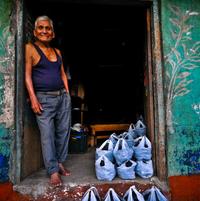Attention in development debates is not often focussed on the income needs of older people. Topics ranging from emergency relief to maternal and child health tend to dominate the discourse. So to redress the balance somewhat, and as I’m writing this on the UN’s International Day for the Eradication of Poverty, here’s a proposition that inclusive social protection for older people may be able to make a substantial contribution to poverty reduction, not only for this age group, but across societies.
Out of the development spotlight, a quiet revolution has begun. Up to the late 1990s only a very small number of low- and middle income countries (LAMICs) had introduced any form of social protection for their older citizens, let alone basic pensions. Since 2000, this has changed, and as rich countries retreat from comprehensive social welfare commitments, many LAMICs are moving in the opposite direction. Over the least two decades there has been a marked increase in the number of countries introducing social protection schemes. Early implementers of social pension programmes among the LAMICs included South Africa in the post-Apartheid era, Nepal and Bolivia in the mid-1990s.
Since the turn of the century the pace of change has accelerated, and numerous countries have been experimenting with pilot social protection schemes, many based on cash transfers to older people. As we shall see, a few have taken the next major step of implementing national social pension schemes.
Challenges remain: in most of the newly-introduced schemes both coverage and adequacy are low. There is also a continued perception that social protection equates to a residual safety net, although this is changing. Implementation processes such as registration, delivery and administration of schemes can also be problematic where government capacity is relatively low.
Not only at country level but among international institutions too the role that social protection programmes can play in the security of older people has been recognised. The International Labour Organisation (ILO) has called for the establishment of “social protection floors” [basic social security guarantees to prevent or alleviate poverty, vulnerability and social exclusion] “as a fundamental element of…national social security systems”, and this is also built into the UN’s Sustainable development goals as well as regional development frameworks in Africa and Asia.
The rise of social pensions
Social pensions are tax-financed non-contributory transfers paid regularly to older people. The relatively low budgetary cost and ease of administration of universal basic pensions mean that they are particularly relevant in low- and middle-income countries. They have well-documented positive impacts for older people and their families, as a World Bank report on basic pensions in Africa shows. Countries with diverse political structures, from Nepal to Costa Rica, have introduced universal basic pensions. A selection of low-income country examples illustrates the progress of the social pension’s idea.
Despite being the poorest country in South America, Bolivia’s pension coverage is one of the highest in the region. This achievement is a result of the implementation of a universal social pension (the Renta Dignidad, or “Dignity Pension”) in 2008 that guarantees a basic pension to all older people over the age of 60. Its principal funding comes from income on hydrocarbon taxes, and the budget for the programme is about 1% of the country’s GDP (2012). This makes it one of the most significant transfers in the region in terms of expenditure, and its outreach (91% of people over 60, compared to the 14% covered by the contributory system) is also significant. A recent study found that the pension is associated with significant poverty reduction, and the benefit is widely popular.
Kenya currently has a means-tested social pension paying 2000 Kenya Shillings ($19) a month to the poorest Kenyans over 65, but has ambitious plans for development. In the current annual budget a universal pension for over 70s is proposed. Time will tell whether the next government will be able to deliver on what was a campaign promise in the recent disputed election, but the early signs are good. By late August nearly half a million older Kenyans had been registered for the scheme, and initial roll-out is promised for early 2018.
Meanwhile neighbouring Uganda has piloted an inclusive Senior Citizens Grant in districts across the country, accessible to every older person living in the pilot areas under the Expanding Social Protection programme. The impact of this programme has contributed towards government thinking on the feasibility and likely effects of going further, and introducing a comprehensive social protection system across the life course. The report for the Ugandan government, available on the Development Pathways website, concludes that by investing just 1% of GDP in programmes accessible for all households with children, older people, and people with disabilities, Uganda could make a ‘significant impact’ on both inequality and poverty levels. With an investment of 3% of GDP, the result would be ‘transformative’. It would nearly halve the national poverty rate from just under 20% to a little more than 10%, almost eliminating poverty among older people, halving it for children, and reducing it by 41% for working age adults.
Can advocacy and public pressure help to persuade governments to implement social protection programmes? An instructive example is that of the introduction of a social pension in Peru, the "Pension 65". My colleague Charles Knox-Vydmanov, who leads HelpAge International’s social protection work, recalls: “I remember vividly conversations around 2009 when it was stated you simply couldn't mention the word ‘social pension’ to policy makers in Peru, there was such strong resistance. A strong advocacy campaign for the introduction of such a scheme included a broad range of organisations (think tanks, parliamentarians, opinion leaders, UN agencies) and also the national association of older persons (ANAMBO). Indeed, it remains one of the stand out examples of what I consider to be a networked approach”.
It also paid off. In 2011, the presidential candidate Ollanta Humala announced (at a meeting of ANAMBO) that he would be taking on their proposal as key election pledge. Opinion polls show it was one of his most popular proposals, and it is not unreasonable to say it tipped the election his way. Once in power, the scheme was introduced, albeit means-tested rather than the near-universal scheme promised, and coverage remains relatively low. But despite the drawbacks the scheme currently provides about $40 per month to half a million older people. A recent impact evaluation showed the scheme had reduced poverty, and also significantly reduced levels of depression amongst older people
It is not all easy going however. Mozambique is one poor country whose social protection schemes for older people and the very young have become a battleground between the proponents of means-tested schemes (notably the World Bank) and universal, rights-based approaches championed by some UN agencies.
Nevertheless, it seems that social protection programmes offering security across the life-course, and with social pensions embedded within them, may be an idea whose time has come in LAMICs. Even in these days of squeezed donor aid budgets they may also be a deserving case for support.
About the Author
Mark Gorman is a Visiting Fellow at OIPA. He is Senior Policy Advisor at HelpAge International. For more information on social pensions around the world visit HelpAge’s Pension watch website.
Comments Welcome
We welcome your comments on this or any of the Institute's blog posts. Please feel free to email comments to be posted on your behalf to administrator@ageing.ox.ac.uk or use the Disqus facility linked below.
Opinions of the blogger is their own and not endorsed by the Institute
Comments Welcome: We welcome your comments on this or any of the Institute's blog posts. Please feel free to email comments to be posted on your behalf to administrator@ageing.ox.ac.uk or use the Disqus facility linked below.













